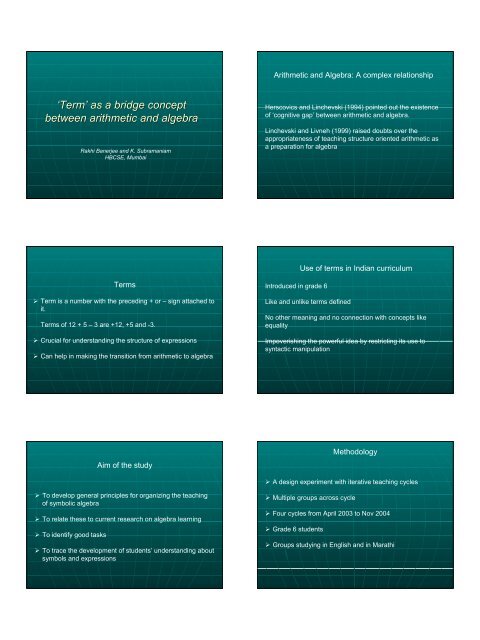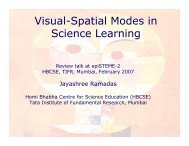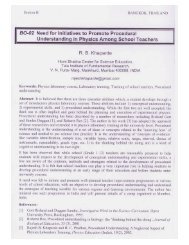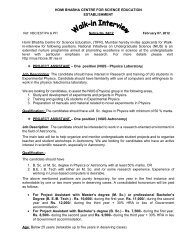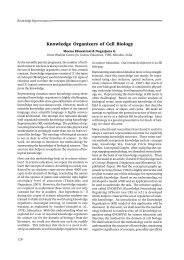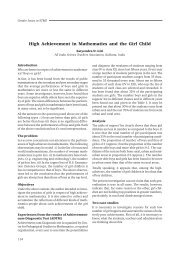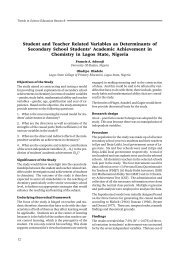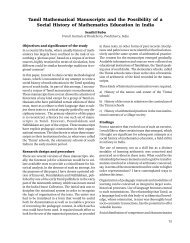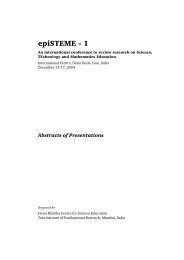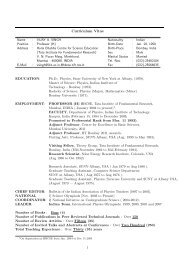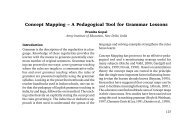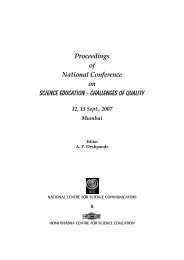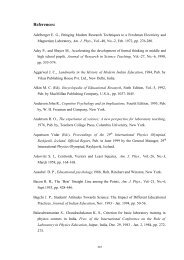Paper(PDF)
Paper(PDF)
Paper(PDF)
You also want an ePaper? Increase the reach of your titles
YUMPU automatically turns print PDFs into web optimized ePapers that Google loves.
Arithmetic and Algebra: A complex relationship‘Term’ as a bridge conceptbetween arithmetic and algebraRakhi Banerjee and K. SubramaniamHBCSE, MumbaiHerscovics and Linchevski (1994) pointed out the existenceof ‘cognitive gap’ between arithmetic and algebra.Linchevski and Livneh (1999) raised doubts over theappropriateness of teaching structure oriented arithmetic asa preparation for algebraUse of terms in Indian curriculumTerms‣ Term is a number with the preceding + or – sign attached toit.Terms of 12 + 5 – 3 are +12, +5 and -3.‣ Crucial for understanding the structure of expressions‣ Can help in making the transition from arithmetic to algebraIntroduced in grade 6Like and unlike terms definedNo other meaning and no connection with concepts likeequalityImpoverishing the powerful idea by restricting its use tosyntactic manipulationAim of the studyMethodology‣ A design experiment with iterative teaching cycles‣ To develop general principles for organizing the teachingof symbolic algebra‣ To relate these to current research on algebra learning‣ To identify good tasks‣ To trace the development of students’ understanding aboutsymbols and expressions‣ Multiple groups across cycle‣ Four cycles from April 2003 to Nov 2004‣ Grade 6 students‣ Groups studying in English and in Marathi
Evaluation/ simplification of arithmetic/ algebraicexpressionsThe use of the concept of ‘term’ in different contextsand tasksExamples: 4 + 6 × 8, 15 – 3 – 7, 13 × y – 4 + 5 – 6 × yConcept of ‘term’Two kinds of terms: Simple term (+ 3) and Product term(– 2 × 3)Simple terms can be combinedProduct term and simple term can be combined byconverting the product term to simple termProduct terms can be combined if they have a commonfactorEquality of expressions‣ Generating equal expressions (like, 23 – 16 + 18 or15 × 8 + 17 – 6) by rearranging terms, splitting terms assum, difference, product, compensating terms‣ Identifying expressions equal to a given expression from alist of expressions‣ Showing an expression to be equal to another bymanipulating one expression (48 – 23 + 12 – 17 = 60 – 40,19 × n – 8 – 5 × n + 1 = 7 × (2 × n – 1))Bracket opening rules‣ Bracket term introduced‣ Equality of expressions made the basis of the rules‣ Inverse of an expression introduced‣ Verbal explanations given whenever needed‣ Writing an expression for number line journeysInteger operations using termsy-3y-2y-1y y+1 y+2 y+3‣ Subtraction same as adding the inverse‣ Distance between two points on the number line‣ Exercise on evaluating expressions by easy ways(-28 + 49 + 8 + 20 – 49, 14 × 3 + 10 × 8 + 14 × 7)
ResultsStructure of expressionsPerformance across phases for bracket opening tasks‣ Identifying terms in an expression: 80% to 100%‣ Generating expressions equal to a given expression:Classroom data good (e.g. 3 – 5 + 2 × 7 = 3 – 2 – 3 + 2 × 7)‣ Identifying an expression equal to a given one from a list ofexpressions:60% to 70% for expressions obtained by rearranging termsBetween 50% to 80% for expressions involving splitting ofterms or using brackets or compensating terms.About 30% correct responses for more difficult questionsIdentify an expressionequal to 18 – (7 + 5)EnglishMarathiApril200425%71%Nov200457%82%‣ Across all bracket opening tasks with + and – to the left:English around 45%, Marathi up from 57% to 70%Syntactic manipulation:‣ Evaluating expressions (e.g. 8 + 5 × 7, 13 – 6 – 3): 90% andabove compared to 70% to 80% in earlier phases‣ Finding easy ways to evaluate long expressions (e.g.-28 + 49 + 8 + 20 – 49) : 80% compared to 50% earlier‣ In many instances students used distributive property tomake evaluation easierTask: Evaluating expression by easyways11×4+9×11–7×11 (one factor common)12×9+16×5–17×9 17×9 (distributivity(twice)m+15–13×13×m–99 (variable factor )English55140Marathi721620Simplifying algebraic expressions: 50% of English mediumand Marathi medium (3rd phase), higher than 2 nd phase 25%for these groupsConjoining error: 15% to 29% for different groupsLetter-number-line journey: 64% English medium and 23%Marathi mediumIn some tasks, e.g. finding distance on the letter-number-line,performance has dropped (30% to 15% for English mediumand 55% to 43% for Marathi medium) with some new errorsappearingEvaluating algebraic expressions: English medium 52% to62% and Marathi medium 85% to 93%
ConclusionThe data suggests that:‣ An approach using ‘terms’ as a key concept helps studentssee the parallels in the structure of arithmetic and algebraicexpressions‣ It allows the students to use their arithmetic sense as aspring-board for algebra learningReferences:Booth, R. (1984) Algebra: Chiddren's strategies and errors, UK:NFER-NELSON publishing company.Chaklin, S. and Lesgold, S. (1984) Pre-algebra students’ knowledgeof algebraic tasks with arithmetic expressions. <strong>Paper</strong> presented atthe annual meeting of the American Research Association.Cobb, P. et al. (2003) Design experiments in educational research,Educational researcher, Vol. 32, pp. 9 -13.Herscovics, N. and Linchevski, L. (1994) A cognitive gap betweenarithmetic and algebra, Educational studies in mathematics, Vol.27, pp. 59-78.Kieran, C. (1989) The early learning of algebra: A structuralperspective. In S. Wagner and C. Kieran (eds), Research issues inthe learning and teaching of algebra, Reston: NCTM.Kuchemann, D. (1981) Algebra. In K. Hart et al. (eds) Children’sunderstanding of mathematics:11-16, UK: John MurrayLinchevski, L. and Livneh, D. (1999) Structure sense: The relationshipbetween algebraic and numerical contexts. Educational studies inmathematics, 40, 173-196.Macgregor, M and Stacey, K. (1997) Students’ understanding of algebraicnotation: 11-15, Educational studies in mathematics, Vol. 33, pp. 1-19.Sfard, A. (1991) On the dual nature of mathematical conceptions:Reflections on processes and objects as different sides of the same coin.Educational studies in mathematics, 22, 1-36.Subramaniam, K. (2004) Naming practices that support reasoning aboutand with expressions. <strong>Paper</strong> presented at ICME-10, Denmark.Tall, D. et al (1999) What is the object of encapsulation of a process?Journal of mathematical behavior, 18(2), 223-241.


